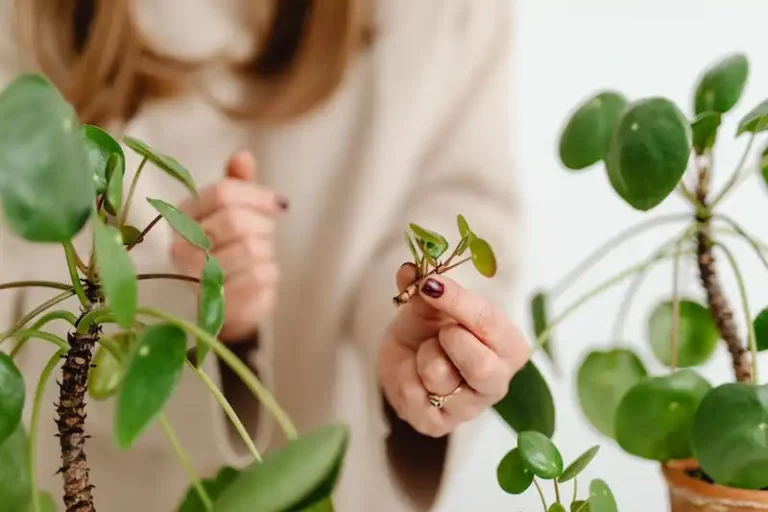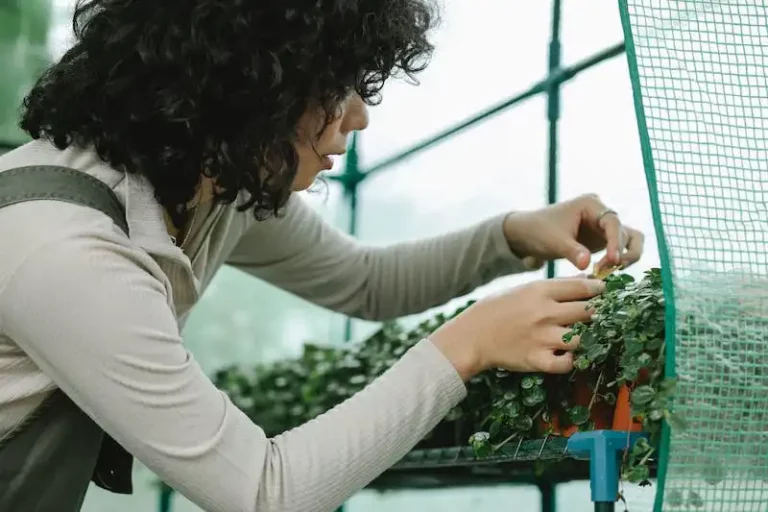Chinese Evergreen (Aglaonema) is a popular indoor plant due to its attractive foliage and easy care requirements. If you’re looking to add a touch of green to your home or office, this plant is a great choice. In this guide, we will discuss how to care for Chinese Evergreen, including planting and growing instructions, as well as some tips for pruning and repotting.
Chinese Evergreen is a tropical evergreen plant that is native to the tropical regions of Asia. It is also known by its botanical name Aglaonema. Chinese Evergreens are known for their beautiful, glossy foliage that comes in a wide range of colors and patterns. Some varieties have dark green leaves with silver or gray markings, while others have lighter or variegated foliage.
When it comes to planting Chinese Evergreen, it is important to use a well-draining potting soil. The plant prefers slightly acidic to slightly alkaline soil. You can also mix some peat moss or compost into the soil to improve its fertility. Chinese Evergreens can tolerate a wide range of light conditions, from bright indirect light to low light. However, they will usually grow better and produce more colorful foliage in brighter light.
It is important to water Chinese Evergreen thoroughly, but make sure to let the soil dry out slightly between waterings. Overwatering can lead to root rot and cause the plant to decline. On the other hand, if the plant becomes root-bound, it may need to be repotted into a larger pot. Chinese Evergreen plants are generally low-maintenance and do not require frequent fertilization. However, a slow-release fertilizer can be applied during the growing season to promote healthy growth and bloom.
Chinese Evergreens are also known for their air-cleaning properties. This means that they can help remove toxins from the indoor air, making them a great addition to your home or office. However, it is worth noting that Chinese Evergreen plants are toxic to cats and dogs, so make sure to keep them out of reach of pets.
Care Guide for the Chinese Evergreen
The Chinese Evergreen, or Aglaonema, is a popular houseplant known for its beautiful foliage and easy care requirements. If you’re considering adding this plant to your indoor collection, follow our care guide below to ensure it thrives in your home.
Light:
Chinese Evergreens prefer bright, indirect light. Place them near a window where they can receive filtered sunlight. Avoid direct sunlight, as it can scorch their leaves.
Temperature:
These plants enjoy average to warm temperatures, with an ideal range of 65-85°F (18-29°C). Avoid exposing them to cold drafts or temperatures below 60°F (15°C).
Watering:
Chinese Evergreens prefer consistently moist soil. Water them thoroughly when the top inch of soil feels dry. Be careful not to overwater, as this can lead to root rot. In winter, reduce watering and allow the soil to dry out slightly between waterings.
Fertilizer:
Feed your Chinese Evergreen with a balanced houseplant fertilizer every two to three months during the growing season (spring and summer). Follow the instructions on the fertilizer package for proper application.
Soil:
Use a well-draining, peat-based potting mix for your Chinese Evergreen. This will help prevent waterlogged roots.
Humidity:
Chinese Evergreens prefer humidity, so consider placing them on a tray filled with water and pebbles to increase humidity around the plant. Misting the leaves can also help maintain humidity.
Pruning:
Remove any yellowing or damaged leaves, as well as any suckers that emerge from the base of the plant. Pruning will help maintain a tidy appearance and encourage new growth.
Toxicity:
Chinese Evergreens are toxic to cats and dogs if ingested. Keep them out of reach of pets to prevent any potential toxicity.
By following these care guidelines, you can enjoy the beauty of Chinese Evergreens in your home. Remember to do some research on specific varieties, as there are many hybrids available with different leaf colors and patterns. Chinese Evergreens are a great choice for indoor gardening enthusiasts, thanks to their tolerance for a range of growing conditions.
Types of Chinese Evergreen
The Chinese Evergreen, or Aglaonema, is a popular houseplant known for its beautiful foliage. There are several different types of Chinese Evergreen, each with its own unique characteristics.
| Type | Size | Light | Watering | Toxicity |
|---|---|---|---|---|
| Aglaonema ‘Emerald Beauty’ | Medium | Bright, indirect light | Keep the soil evenly moist, but not waterlogged | Mildly toxic to cats and dogs |
| Aglaonema ‘Silver Bay’ | Medium | Medium to low light | Allow the top inch of soil to dry out between waterings | Mildly toxic to cats and dogs |
| Aglaonema ‘Red Siam’ | Medium | Medium to low light | Water when the top inch of soil feels dry | Mildly toxic to cats and dogs |
| Aglaonema ‘Maria’ | Medium | Medium to low light | Water when the top inch of soil feels dry | Mildly toxic to cats and dogs |
These are just a few examples of the different types of Chinese Evergreen available. The size, light requirements, watering needs, and toxicity level can vary slightly between different varieties. It’s important to choose a Chinese Evergreen that suits your specific needs and preferences.
Aglaonema
Aglaonema, also known as Chinese Evergreen, is a popular indoor plant that is loved for its beautiful foliage. It is native to the tropical regions of Asia and is widely grown as a houseplant in many homes.
The Aglaonema plant has thick, leathery leaves that come in various shades of green, silver, and even variegated combinations. Some varieties of Aglaonema have striking veining patterns on their leaves, adding to their visual appeal.
Aglaonema plants are relatively low-maintenance and can be grown in a variety of climates and light conditions. They prefer bright, indirect light but can tolerate lower light levels as well. However, it’s important to note that too much direct sunlight can burn their leaves, so it’s best to keep them away from windows that receive intense sunlight.
When it comes to watering, Aglaonema plants prefer to dry out slightly between waterings. It’s advisable to water them when the top inch of soil feels dry to the touch. Overwatering can cause their roots to rot, so it’s important to provide proper drainage and avoid waterlogged soil.
Aglaonema plants have moderate humidity requirements and can tolerate average indoor humidity levels. However, they may benefit from occasional misting, especially in dry environments or during winter when indoor air tends to be drier.
When caring for Aglaonema, repotting is generally needed only when the plant becomes root-bound. This typically occurs every two to three years. It’s important to use a well-draining potting soil mix and a container with drainage holes to prevent waterlogging.
Pruning may occasionally be required to remove any damaged or dead leaves. It’s best to use clean, sharp pruning shears to make clean cuts and avoid tearing the leaves.
If you’re looking to propagate your Aglaonema plant, it can be done through division or by taking stem cuttings. Division involves separating the plant into smaller sections, making sure each section has a good root system. Stem cuttings can be taken from the mother plant and rooted in water or moist soil.
Aglaonema plants are generally safe for pets, including cats and dogs. However, it’s always a good idea to keep an eye on your pets and make sure they don’t chew on the leaves or ingest any parts of the plant.
Aglaonema is a versatile and beautiful plant that can thrive in various environments. Whether you’re a beginner or an experienced gardener, this plant can be a great addition to your indoor garden.
| Plant Care | Troubleshooting |
|---|---|
| – Provide bright, indirect light. | – Yellowing leaves may indicate overwatering. |
| – Water when the top inch of soil is dry. | – Browning leaf tips may be caused by low humidity. |
| – Use well-draining potting soil. | – Fungal diseases can be caused by overwatering. |
| – Repot every two to three years. | – Spider mites can be a common pest. |
| – Prune to remove damaged leaves. | – Suckers can be removed to control plant size. |
Aglaonema is a beautiful and relatively easy-to-care-for plant that can bring a touch of tropical beauty to your home. Whether you’re a new plant parent or an experienced gardener, this guide to Aglaonema care will help you keep your plant happy and healthy.
Characteristics
Chinese Evergreen, or Aglaonema, is a popular houseplant known for its attractive foliage and easy care requirements. It can stand in lower light conditions than many other houseplants, making it an excellent choice for those with less sunny spaces.
The growth rate of Chinese Evergreen is relatively slow, and it can reach up to 3-4 feet in height. It has variegated foliage, with colors ranging from light green to darker shades. The plant can also produce flowers, but they are not very showy and are mainly grown for their foliage.
Caring for Chinese Evergreen is relatively simple. It requires low to moderate watering, allowing the soil to dry out between waterings. Overwatering can lead to root rot, so it’s important to ensure proper drainage. The plant also appreciates higher humidity levels, so placing a tray of water nearby or misting the leaves can help create a more favorable environment.
Chinese Evergreen can be grown in USDA hardiness zones 10-11 and can also be kept as a potted plant indoors. It thrives in well-draining soil and benefits from regular fertilizing with a balanced fertilizer. Follow the instructions on the fertilizer packaging for the appropriate dosage and frequency.
Pruning is not necessary for Chinese Evergreen. However, if the plant becomes overgrown or leggy, it can be pruned back to encourage bushier growth. Pruning should be done in spring or summer when the plant is actively growing.
Propagation of Chinese Evergreen can be done through division. Simply divide the plant at the root ball and repot each division into its own pot. Repotting should be done every 1-2 years or when the plant has outgrown its current pot.
Chinese Evergreen is generally a low-maintenance plant, but like many other houseplants, it can be prone to common pests such as aphids and spider mites. Regularly inspect the foliage for any signs of infestation and treat as necessary with insecticidal soap or a natural pest control solution.
In conclusion, Chinese Evergreen is a beautiful and versatile plant that can thrive in a variety of indoor environments. With the basics of proper watering, fertilizing, and occasional pruning, you can enjoy this attractive plant for years to come.


